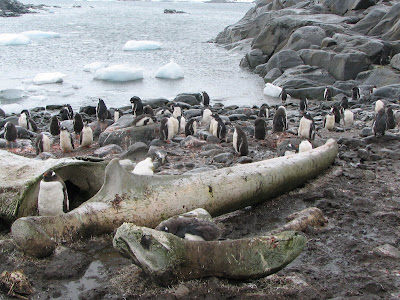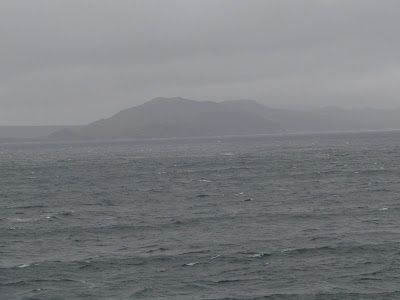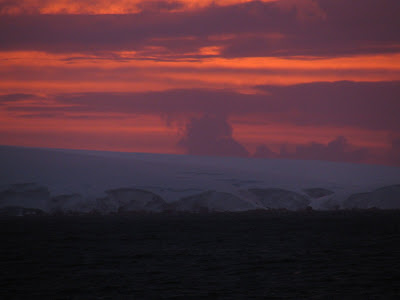This morning, we awake to very heavy winds. Late yesterday or this morning, we had moved north out of the Lemaire Channel and up toward Wiencke Island. The objective of the morning is to visit the former British research base, Port Lockroy. It is supposed to be an interesting place. Although no longer used for research, it is open during summer months as a museum, and also has a colony of Gentoo penguins there that are as tame as any around.
The history of Port Lockroy is interesting. It was built in 1944, during World War II, primarily as a defensive position to watch potential Nazi activities in the Antarctic Peninsula. As improbable as it sounds, the Peninsula did factor into some strategic thinking back then. Argentina was allied with Germany, and the concern was that if the Nazi’s controlled the Antarctic Peninsula, they would control both sides of the Drake Passage, and therefore potentially all east-west shipping through the Drake. So Port Lockroy was built, supposedly for science, but served as a major listening post. After the war, attention turned to real science, and it was in operation until the 1960’s, I think.
We’re interested in seeing this, but the winds and the seas are casting doubt on whether the zodiacs will be able to operate today. The start of the excursion is delayed while they watch the weather. Meanwhile, I am not feeling well again, and have all but decided to forego this excursion if they do it. After a while, they announce that the trip is on, but that they will only operate 5 zodiacs, so they will have to do the excursion in 2 shifts. Joan goes down to the Mud Room, and I go back to bed. A short while later though, Joan is back in the room. She did not make the first half, and will need to go in the 2nd wave. By the time they announce the 2nd grouping, I have had some sleep, and decide to go after all. We talk to some of the people coming back, and they look like drowned rats! The winds totally sprayed them on their trip back to the ship. We figure we will just grit our teeth and bear it.
We head out, and find that the seas are definitely choppier than anything we’ve seen up until now, but not so bad as to really cause concern. And on this leg of the trip, the wind is at our back, so, we don’t get sprayed either. We make landing, and see some small buildings, a British flag flying, and penguins everywhere. And penguin crap too, I might add. This was a rocky crag of land, overwhelmed by the penguin population, and very, very dirty. We felt sorry for the penguins, and for the people who would have to be stationed here. We take a few pictures however, and come away with some pretty nice ones, particularly of penguins with water and ice backgrounds. Inside the buildings, we wander thru the little shop and the various rooms that have been left as they existed 40-50 years ago. They lived a very rough existence here, and seeing this helps you appreciate the pioneering spirit that these early station residents must have had…. Especially when you realize that they did not have the warm clothing technology that we take for granted today. We buy post cards for the kids, and British Antarctic Territory stamps, and mail them from the Port Lockroy post office. (We will see later that Dave’s arrives in about 4 weeks, Debbie’s in 6 weeks.)
We go back outside, and decide that we don’t need to spend too much more time here. We get into the waiting zodiac, and head back to the ship. Fortunately, by this time the winds from this morning have really subsided, so we have none of the problems with spray heading in this direction that the first group had. That is appreciated greatly! We are back on the Ioffe by 12:45, and have lunch.
Port Lockroy, the former British research station which now serves as a museum. It depicts the nature, and the artifacts, of Antarctic life in the 1940s and 1950s. It was a tough existence back then. I'm sorry that I did not get any good pictures of the exhibits inside, or of the gift shop / post office which was staffed by a couple of friendly people. Outside, though, there was a very large and very tame colony of gentoo penguins waiting to be photographed.

The grounds and the shoreline around the research station were anything but beautiful! There was mud and penguin excrement everywhere. A whale bone is on the shoreline in this picture.

 Everywhere we looked, we saw penguin cuteness mixed with absolute filth. It was an odd combination, and a bit sad.
Everywhere we looked, we saw penguin cuteness mixed with absolute filth. It was an odd combination, and a bit sad. But I guess the penguins don't mind, and don't form the value judgments of the beauty or ugliness of a place that we humans do. Scientists have actually done extensive studies on this particular population here at Port Lockroy, to see if living near humans negatively affects them. The conclusion: They are doing just fine.
But I guess the penguins don't mind, and don't form the value judgments of the beauty or ugliness of a place that we humans do. Scientists have actually done extensive studies on this particular population here at Port Lockroy, to see if living near humans negatively affects them. The conclusion: They are doing just fine.

 View from the front steps of the Port Lockroy station. The sled seemed to be there for its museum interest, as opposed to serving any current practical function.
View from the front steps of the Port Lockroy station. The sled seemed to be there for its museum interest, as opposed to serving any current practical function.
 Port Lockroy is now staffed only during the summer months, but is apparently available for touring anytime. The sign on the inside of the door reminds the last one out what he or she is supposed to do.
Port Lockroy is now staffed only during the summer months, but is apparently available for touring anytime. The sign on the inside of the door reminds the last one out what he or she is supposed to do. This is one of our favorite penguin photos. Joan spotted this guy on the shoreline, with the perfect backdrop, and he just seemed to be posing and asking for his picture to be taken. We were happy to oblige.
This is one of our favorite penguin photos. Joan spotted this guy on the shoreline, with the perfect backdrop, and he just seemed to be posing and asking for his picture to be taken. We were happy to oblige.
Excursion #2 after lunch is to Dorian Bay, a point that offers a climb up a hillside, we are told. We get out at a point at which there is a small shed. Looking inside we see boxes of provisions and a snowmobile. It looks like a shed that is maintained for emergencies in case someone was to get stuck here in the middle of winter. Then we start our climb up the hill…. Working our way up to a ridge top perhaps 200 feet high. At the top, we look down the other side, and are surprised to find ourselves looking down on Port Lockroy! We have simply come one bay over from where we had been this morning. It is interesting to look down on that place.
We head back down, and climb into the zodiac. Since this will be our last excursion, it is also the last time we will set foot on Antarctic ground, and we say “goodbye”. Two minutes out from the shore, though, we see on a jut of land to our left a seal and penguins, and we talk our driver, Mo, into taking us there and dropping us off for a closer look. Our first thought was that a leopard seal was coming up for dinner, but we now see that it is just a fur seal… actually 2 of them, and they seem to coexist nicely with the Gentoos all around them. We take some pictures and then start walking back to our original spot, along the perimeter of the bay. We get back in time to see the Antarctic Polar Bear Swim Club in action. Yes, about 20 brave (or other adjectives may apply too?) souls have decided to strip down to bathing suits, or underwear, or in some cases, birthday suits, and take a plunge in the waters to join a select club of Antarctic swimmers. They apparently get an official certificate to note this. For the third time (first two were kayaking and overnight camping), Joan and I pass on an optional activity. This one was a no-brainer.
A good view of what is meant by a "wet landing". All landings from the zodiacs were wet landings. This was the start of our afternoon excursion on this day. 
 A storage shed for supplies. It is located on a hill. Its raised foundation is not to protect it from high waters, but rather to provide access during heavy snows. The equipment needed to clear away snow and ice is kept handy on the outside wall.
A storage shed for supplies. It is located on a hill. Its raised foundation is not to protect it from high waters, but rather to provide access during heavy snows. The equipment needed to clear away snow and ice is kept handy on the outside wall. After a brief look around, we find ourselves climbing another hill. Seems like a lot of our outings here involve climbing hills!
After a brief look around, we find ourselves climbing another hill. Seems like a lot of our outings here involve climbing hills! Midway up the hill, looking back at the bay.
Midway up the hill, looking back at the bay. At the crest of the hill, we are surprised to find ourselves looking down on Port Lockroy. We did not realize that we had simply gone "one bay over" from where we were this morning. Looking closely, we see a zillion little dots that are penguins.
At the crest of the hill, we are surprised to find ourselves looking down on Port Lockroy. We did not realize that we had simply gone "one bay over" from where we were this morning. Looking closely, we see a zillion little dots that are penguins.
A fellow traveler snapped this photo of us with Port Lockroy in the background.
 Back down the hill, we explore another storage shed. The flag painted on the side tells us this is an Argentine facility.
Back down the hill, we explore another storage shed. The flag painted on the side tells us this is an Argentine facility. Peeking in the windows, we see that there are many crates of emergency materials staged here. The tarp covers a snowmobile.
Peeking in the windows, we see that there are many crates of emergency materials staged here. The tarp covers a snowmobile. On the shoreline nearby, gentoo penguins and a fur seal appear to be comfortably coexisting. The fur seals, unlike their leopard seal cousins, pose no danger to the penguins, and the penguins seem to recognize that.
On the shoreline nearby, gentoo penguins and a fur seal appear to be comfortably coexisting. The fur seals, unlike their leopard seal cousins, pose no danger to the penguins, and the penguins seem to recognize that.

 After a while, the fur seal is joined by a friend, and we enjoy watching them interact. They remind us of a couple of dogs playing.
After a while, the fur seal is joined by a friend, and we enjoy watching them interact. They remind us of a couple of dogs playing.



We are back on board and before dinner, there is an auction, in which a variety of paraphernalia is auctioned off by the crew, all proceeds to benefit the “Save the Albatross” effort. Some of the items generate some serious money. All told, over $6000 was collected.
During the auction, we pulled anchor and started our journey north, toward the Drake and the start of the trip home. By dinner time, we have hit the open waters, and the going gets quite rough. A couple of times we lurch so violently that things fall around on the tables. At one point as I am trying to move in the dining room, I am thrown against one table and a few things tip. It looks like the Drake will be in a more ornery mood than it was when we came down. I have already put a patch on for seasickness, and it seems to be working well, but Joan has retired to the room, and has gotten sick a couple of times already.
At around 9 pm, the waves increase further. There is a huge amount of motion on the ship, side to side. We must secure everything around the cabin to keep it from flying about. I look out the window, and see a wonderful sunset to the west, illuminating clouds over the last viewable sloping hillsides of an Antarctic island, and reflecting orange and red in the water. I take about 20 pictures…. Our last view of Antarctica, and a very picturesque one at that.
I continue to look out the window, and I watch the waves. They are still increasing in size. I watch in amazement at the peaks and valleys of the swells, and get a clear sense of the constantly changing height of my eye above the water. When the boat is in a trough between waves, I see the water level as I am used to seeing it. Then, as we rise to the top of a swell, I see the water level appear to drop away from me by as much as 20 or 30 feet.
After a while I try to go to sleep. Joan already is. It is hard to sleep when the ship is pitching as it is, but I finally drift off.
Final views of Antarctica and an impressive sunset, as our ship makes its way out toward the open seas of the Drake Passage.
































































